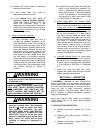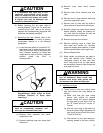
11
4-7. LUBRICANT SPECIFICATIONS
CONT’D.
AMBIENT TEMPERATURE
-20° to 50°F 50° to 100°F 100° to 250°F
(-29° to
+10°C)
(10° to 38°C) (38° to 121°C)
GCOT
AGMA Lubricant No. 5S No. 8 Compounded
ISO Viscosity Grade 220 680
American Lubricants
SHC 90W AGMA #8 Gear Oil
Mobil
Oil Corp. Mobil SHC
630
Extra Hecla Super
Shell
Oil Co. Omala RL
220
Valvata J 680
Fiske Brothers
SPO-MG SPO-288
Gear Case
Oil.
Traverse
Gear Case.
Texaco
Inc. Pinnacle
220
Vanguard
680
Refer to Yale Hoist
Field Service
Department for
Gearcase Operating
Temperatures above
200°F.
SECTION V – INSPECTION AND
PREVENTATIVE MAINTENANCE
5-1. GENERAL. All Yale “Global King” hoists are
inspected and tested at the factory. Regular in-
service inspection and preventative maintenance
programs not only help reduce overall maintenance
costs but may also prevent service shutdowns by
forewarning of problems that could cause these
shutdowns. Regular inspections, periodic minor
adjustments, regular cleaning and lubrication and
replacement of worn parts can help preserve good
performance and operation of your hoist.
Many factors influence the inspection and
preventative maintenance program required for your
hoist. Frequency and severity of service and material
handled, local environmental conditions and various
applicable codes are some of the factors that the
user must consider to adjust inspection and
maintenance program outlined in this section to
meet his specific conditions.
The inspection and maintenance services outlined in
this section are considered minimum.
Recommended in the schedule are minimum
inspection and maintenance intervals based on
average daily use in a normal environment. Average
daily use is based on 1000 total operational hours
per year maximum and intermittent operation of the
hoist eight hours per day, five days per week with a
maximum 50 percent “on” time and the average
loading not exceeding 65 percent of rated load. For
more details regarding hoist duty cycles, please
reference ANSI/ASTM HST-4.
Environmental conditions in which the hoist operates
are also important considerations for the user when
adjusting hoist inspection and maintenance
programs to local conditions. Frequency of
inspection and maintenance must be increased if
hoist is subjected to severe atmospheric
environmental conditions, such as corrosive vapors,
extreme heat or cold, cement or dust and other
airborne contaminants. The user should carefully
consider all environmental conditions and adjust
frequency and degree of maintenance for his local
conditions. Consult the factory’s Field Service
Department for advice regarding unusual environ-
mental conditions.
Various codes also regulate inspection and
maintenance programs. Attention must be given to
applicable federal standards, OSHA regulations,
national standards, state and local codes which may
include mandatory rules relating to hoist inspection
and maintenance. The user should become familiar
with all applicable codes for his area and be guided
accordingly.
Listed on the Recommended Inspection and
Maintenance Schedule are inspection frequencies
and requirements. Perform these inspections
regularly as scheduled and additional inspections as
may be required for activity, service, and environ-
ment of your hoist. The hoist operator must be
responsible for determining the operating conditions
and severity of service.
Inspection Schedule and Maintenance Report Form.
Shown on page 13 of this manual is a recommended
Inspection Schedule and Maintenance Report form
that lists various components of the hoist. The form
also includes trolley components, runway com-
ponents, and miscellaneous items. This form is
suggested as a guide for written inspection reports.
Inspections are recommended each month and
should be performed thoroughly enough to inform
the hoist user of deficiencies for any item listed. This
form does not supersede the Inspection and
Maintenance Schedule listed on page 12 of this
manual but may be used to record scheduled
inspection and maintenance services required.


















